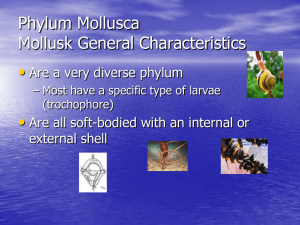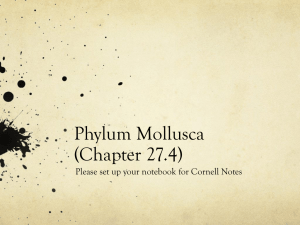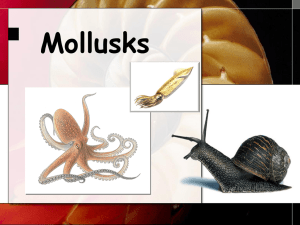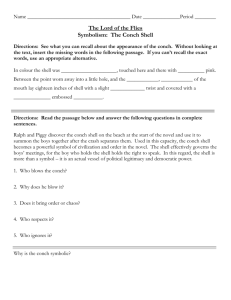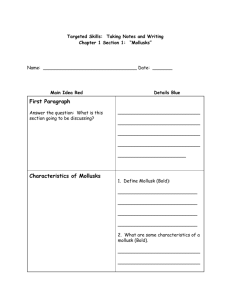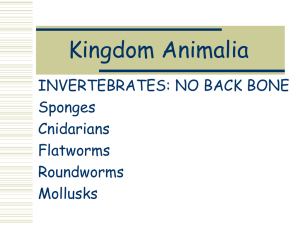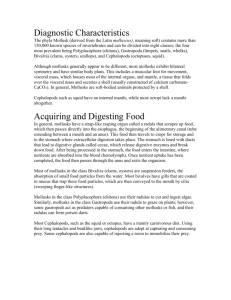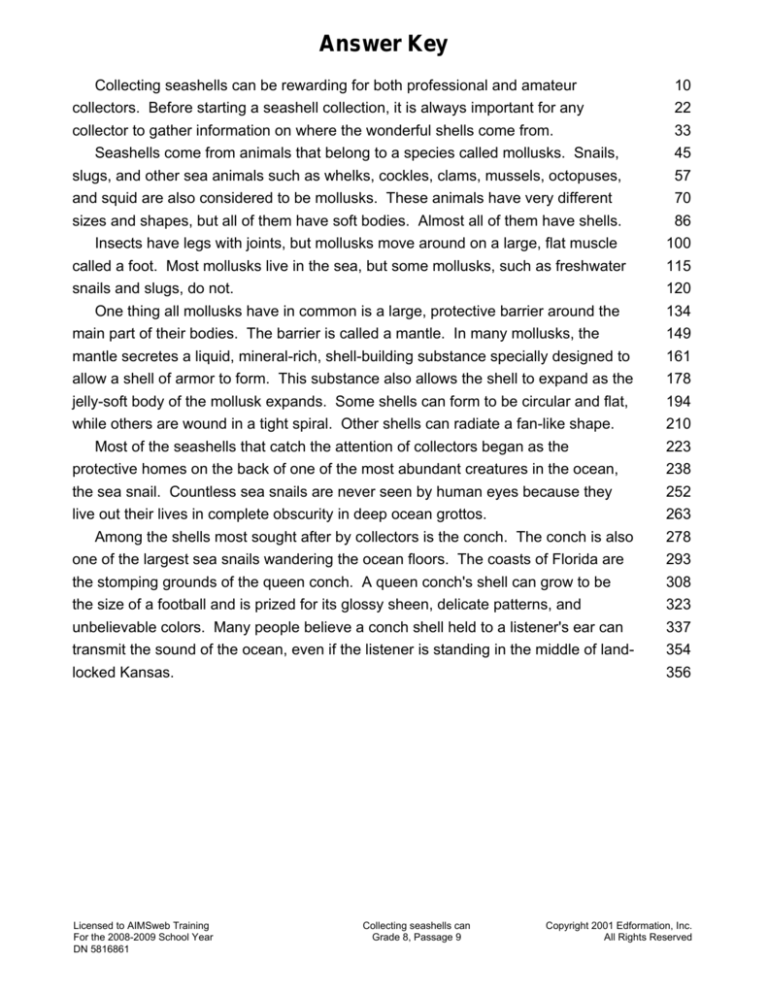
Answer Key
Collecting seashells can be rewarding for both professional and amateur
collectors. Before starting a seashell collection, it is always important for any
collector to gather information on where the wonderful shells come from.
Seashells come from animals that belong to a species called mollusks. Snails,
slugs, and other sea animals such as whelks, cockles, clams, mussels, octopuses,
and squid are also considered to be mollusks. These animals have very different
sizes and shapes, but all of them have soft bodies. Almost all of them have shells.
Insects have legs with joints, but mollusks move around on a large, flat muscle
called a foot. Most mollusks live in the sea, but some mollusks, such as freshwater
snails and slugs, do not.
One thing all mollusks have in common is a large, protective barrier around the
main part of their bodies. The barrier is called a mantle. In many mollusks, the
mantle secretes a liquid, mineral-rich, shell-building substance specially designed to
allow a shell of armor to form. This substance also allows the shell to expand as the
jelly-soft body of the mollusk expands. Some shells can form to be circular and flat,
while others are wound in a tight spiral. Other shells can radiate a fan-like shape.
Most of the seashells that catch the attention of collectors began as the
protective homes on the back of one of the most abundant creatures in the ocean,
the sea snail. Countless sea snails are never seen by human eyes because they
live out their lives in complete obscurity in deep ocean grottos.
Among the shells most sought after by collectors is the conch. The conch is also
one of the largest sea snails wandering the ocean floors. The coasts of Florida are
the stomping grounds of the queen conch. A queen conch's shell can grow to be
the size of a football and is prized for its glossy sheen, delicate patterns, and
unbelievable colors. Many people believe a conch shell held to a listener's ear can
transmit the sound of the ocean, even if the listener is standing in the middle of landlocked Kansas.
Licensed to AIMSweb Training
For the 2008-2009 School Year
DN 5816861
Collecting seashells can
Grade 8, Passage 9
10
22
33
45
57
70
86
100
115
120
134
149
161
178
194
210
223
238
252
263
278
293
308
323
337
354
356
Copyright 2001 Edformation, Inc.
All Rights Reserved
Collecting seashells can be rewarding for both professional and amateur
collectors. Before starting a seashell collection, it is always important for any
collector to gather information on where the wonderful shells come from.
Seashells come from animals that belong to a species called mollusks. Snails,
slugs, and other sea animals such as whelks, cockles, clams, mussels, octopuses,
and squid are also considered to be mollusks. These animals have very different
sizes and shapes, but all of them have soft bodies. Almost all of them have shells.
Insects have legs with joints, but mollusks move around on a large, flat muscle
called a foot. Most mollusks live in the sea, but some mollusks, such as freshwater
snails and slugs, do not.
One thing all mollusks have in common is a large, protective barrier around the
main part of their bodies. The barrier is called a mantle. In many mollusks, the
mantle secretes a liquid, mineral-rich, shell-building substance specially designed to
allow a shell of armor to form. This substance also allows the shell to expand as the
jelly-soft body of the mollusk expands. Some shells can form to be circular and flat,
while others are wound in a tight spiral. Other shells can radiate a fan-like shape.
Most of the seashells that catch the attention of collectors began as the
protective homes on the back of one of the most abundant creatures in the ocean,
the sea snail. Countless sea snails are never seen by human eyes because they
live out their lives in complete obscurity in deep ocean grottos.
Among the shells most sought after by collectors is the conch. The conch is also
one of the largest sea snails wandering the ocean floors. The coasts of Florida are
the stomping grounds of the queen conch. A queen conch's shell can grow to be
the size of a football and is prized for its glossy sheen, delicate patterns, and
unbelievable colors. Many people believe a conch shell held to a listener's ear can
transmit the sound of the ocean, even if the listener is standing in the middle of landlocked Kansas.
Licensed to AIMSweb Training
For the 2008-2009 School Year
DN 5816861
Collecting seashells can
Grade 8, Passage 9
Copyright 2001 Edformation, Inc.
All Rights Reserved

